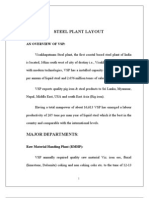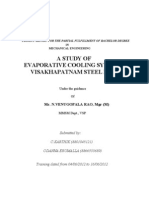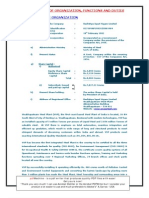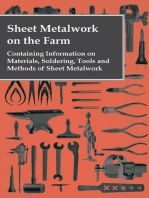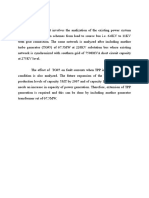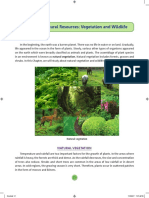Chapter-3: Profile of Visakhapatnam Steel Plant
Uploaded by
rajuChapter-3: Profile of Visakhapatnam Steel Plant
Uploaded by
raju23
Chapter-3
PROFILE OF
VISAKHAPATNAM STEEL PLANT
3.1 BACKGROUND
The government of India was for long deliberating to set up an integrated
steel in the southern part of the country. After lot of study and planning
Visakhapatnam shore based town was selected for the same. Selection committee
chose the site close to the Balacheruvu creek and the Prime Minister did the formal
inauguration on 20th January 1971.
The consultant M/s M.N. Dastur and Co., Ltd submitted a detailed project
report (DPR) for the plant with an annual capacity of 3 million of liquid steel in
October 1977.
The Russians examined the DPR prepared by Dastur and offered Economic
and Technical co-operation for the same followed by an agreement signed with
erstwhile USSR on June 12 th 1979 for co-operation in setting up 3.4 MT integrated
steel plant at Visakhapatnam.
A Comprehensive Revised DPR (CRDPR) was
revised by Soviet and Indian design organisation in 1980.
The project was estimated to cost Rs. 3897.28 crores based on prices as on
4th quarter of 1981. However on completion of construction and commissioning of
the whole plant in 1992 the cost is estimated to be Rs. 8,755 crores based on
prices as on 2nd quarter of 1994.
Unlike other integrated steel plants in India
Visakhapatnam Steel Plant is one of the most modern steel plants in the country.
New technology, large-scale computerisation and automation etc., are incorporated
24
in the plant. To operate the plant at international levels and attain such labour
productivity, the total manning of the organisation has been limited to 17500
employees. The plant has a capacity of producing 3.0 MT of Liquid steel and 2.656
MT saleable steel.
3.2 MAJOR SOURCE OF RAW MATERIALS
S.No.
1
2
3
4
5
6
7
8
Raw material
Iron ore lumps and fines
BF lime stone
SMS lime stone
BF Dolomite
Source
Bailadilla, MP
Jagayyapeta, AP
Jaisalmer, Rajasthan
Dubai
SMS Dolomite
Manganese Ore
Boiler coal
Coking coal
Madharam, AP
Chipurupalli, AP
Talcher, Orissa
Australia
Table 3.1 Raw materials and their Sources
3.2 THE MAJOR PRODUCTION FACILITIES OF VSP
3.2.1 RAW MATERIALS HANDLING
Some of the major raw materials required for the making of iron and steel
are iron ore lumps and fines, coking coal, limestone, manganese and dolomite.
VSPs requirements are met by various mines located in the states of Madhya
Pradesh, Rajasthan, Orissa and Andhra Pradesh. VSP has its own captive mines
at Jaggayyapeta and Madharam in Andhra Pradesh for limestone and Dolomite
respectively. BF dolomite is obtained from Dubai and coking coal is imported from
Australia.
3.2.2 COKE OVENS & COAL CHEMICAL PLANT
25
Coking coal after selective crushing and proper blending is subjected to
destructive distillation (heating in the absence of air) in the Coke Ovens. After
heating for nearly a period of 16-18 hours at a temperature of about 1100 o C, coke
is obtained and is used as a fuel as well as reducing agent in the Blast Furnace.
The Coke Ovens of VSP are engineering feats by themselves. They are the tallest
ovens metre constructed in the country. The Plant has 3 batteries, which are 7
metres tall. Each battery consists of 67 ovens. Another feature is the dry cooling of
coke carried out by the inert gas nitrogen thus, reducing pollution considerably.
Besides a bio-chemical plant separately undertakes the treatment of effluents. Byproducts like benzene, toluene, xylene, naphthalene, coal tar, creosote oil, pitch,
ammonium sulphate and benzol products are also recovered from the coke ovens
gas. VSP produces, among other by-products, Pushkala a prime fertilizer based
on ammonium sulphate.
3.2.3 SINTER PLANT
Iron ore fines, coke breeze, limestone and dolomite along with recycled
metallurgical wastes are converted into agglomerated mass at the Sinter Plant,
which forms 80% of iron bearing charge in the Blast Furnace. The Sinter Plant
comprises of two sinter machines each having 312 square metres of grate area
with a total production capacity of 5.256 million tonnes per annum.
3.2.4 BLAST FURNACE
VSP has two Blast Furnaces with an effective volume of 3200 m 3. each of
which are the largest in the country. Blast Furnace is charged with coke, iron ore
and sinter from the top and produces about 5000 tonnes of molten iron per day. Its
novel circular cast house with four tap holes ensures continuous tapping of hot
26
metal. The annual production capacity of these Blast Furnaces is 3.4 million tonnes
of liquid iron.
3.2.5 STEEL MELT SHOP & CONTINUOUS CASTING
Three Top-blown converters, each of 133m 3 volume, produce a total of 2.7
million tonnes of liquid steel per annum. This liquid steel thus produced is cast in
six-4 strand bloom casters. A special feature in energy conservation is the collection
of Converter gas to be used as a fuel in the plant. The entire molten steel at VSP is
continuously cast at the radial type continuous casting machines resulting in
significant energy conservation and better quality steel. 100% Continuous casting
on such a large scale has been conceived for the first time in India.
3.2.6
ROLLING MILLS
The cast blooms from continuous casting department are treated and rolled
into various long products of different specifications at 3 high capacity continuous
rolling mills. They are:
(a)
Light & Medium Merchant Mill: - The mill consists of a Billet Mill
capable of rolling 1,915,000 tonnes of 250 mm x 320 mm blooms into
1,857,000 tonnes of 125 mm x 125 mm billets and a bar mill designed to roll
7,26,000 tonnes of billets to 710,000 tonnes of finished light merchant
products like rounds, rebars, squares, equal and unequal angles, flats, Tbars and channels.
(b)
Wire rod mill: - This is equipped with Morgan blocks and Stelmor
technology having a capacity of 850,000 tonnes per annum utilizing the
billets from billet mill as feed stock.
27
(c)
Medium Merchant and Structural Mill: - This has capacity to roll
850,000 tonnes per annum of medium merchant products including universal
beams directly from continuous cast blooms.
3.2.7 THERMAL POWER PLANT
A captive power plant, which can generate a total of 287 MW of power
produces power from fuels like coal, waste gases and oil. This can meet the total
power requirement of the steel plant, and even export about 50 MW power to the
state power grid.
3.2.8 WATER SUPPLY
Requirements of water during the peak construction were of the order of 4.5
mgd. This was met from the Meghadrigedda and Raiwada schemes of AP State
Government. Operational water requirements 36 mgd, is being met from the Yeluru
water supply scheme provided by the AP State Government.
This involved
construction of storage reservoir at Yeleswaram and a 153 kms. long line canal to
the plant site apart from Kanithi Balancing reservoir.
3.3 VSPs SPECIAL FEATURES
7-meter tall coke oven batteries with coke dry quenching.
Biggest Blast furnaces in the country.
Bell less top charging system in blast furnace.
100% slag granulation at the blast furnace cast house.
Suppressed combustion LD gas recovery system.
100% continuous casting of liquid steel.
Tempcore and Stelmor cooling process in LMMM and WRM
respectively.
Extensive waste recovery systems.
High speed rolling mills.
28
Compressive pollution productivity & highest level labour productivity.
3.4 PRODUCTION CAPACITIES SHOP-WISE
Annual cap
Department
Units (3.0 MT stage)
000 T
Coke ovens
2261
3 Batteries each of 67 ovens and 7 Meter
height
Sinter Plant
5256
2 Sinter machines of 213 m2 grate area
each
Blast furnace
3400
2 Furnaces of 3200 m3 volume each
Steel melt shop
3000
3 LD converters each of 150 m3 volume
and strand bloom casters
LMMM
710
3 Stand finishing mill
WRM
850
2 x 10 stand finishing mill
MMSM
860
6 stand finishing mill
Table 3.2 Production capacities shop-wise
3.5 MAJOR PLANT FACILITIES
Visakhapatnam Steel Plant has the following production facilities.
Three Coke Oven Batteries of 67 ovens, each having 41.6 M 3 volume.
Two Sinter Machines of 312 M2 area each.
Two Blast Furnace of 3200 M3 useful volumes each.
Steel Melt Shop with three L.D. Converters of 150 tonnes capacity each
and 6 numbers of four strand continuous bloom casters, which can
produce 3 MT of liquid steel per annum.
Light and Medium Merchant Mill (LMMM) of 710,000 tonnes per year
capacity.
Wire Rod Mill (WRM) of 850,000 tonnes per year capacity.
Medium Merchant and Structural Mill (MMSM) of 850,000 tonnes per
year capacity.
29
Additional facilities have been provided for repair and maintenance as well
as manufacture of spare parts. A Captive Power Plant of 287.5 MW, Oxygen Plant,
Acetylene Plant, Compressed Air Plant, etc, also form a part of the facilities.
3.6 THE TECHNOLOGICAL PROCESS IN VSP
The raw material iron ore in itself does not hold any value for the mankind.
However once it gets converted into iron, through metallurgical reduction process, it
holds a vast potential for use as a versatile metal. It is this basic process that is
taking place in an integrated steel plant like VSP, which is explained in brief here.
Raw Material Handling Plant receives all the input process raw materials like
iron ore lumps and fines, coking and non-coking coal, limestone, dolomite, etc.,,
through railway wagons.
The raw materials are prepared to the process
requirement of size & specifications using crushers, screeners and different types of
stacking and reclaiming machinery. Coking coal is converted into metallurgical coke
at 'Coke Ovens' (CO). Coke is used as the essential raw material in iron making.
During the conversion, saleable by-products like Ammonium Soleplate, Benzyl, Tar,
and Naphthalene are extracted from the flue gases generated in Coke Ovens, at
'Coal Chemical Plant' (CCP).
At the Sinter Plant iron ore fines are agglomerated by partial heating into
lumps (called sinter) along with other essential additives & coke fines, for charging
into the Blast Furnace for the iron reduction process. Sinter, Coke and Limestone
charged from the top of the Blast furnace (BF) gradually descends to the bottom in
the hot outgoing gases. The liquid iron and slag (silicon impurities) get collected in
the bottom and get separated from one another, the slag being lighter.
30
Both iron and slag are tapped and the slag is diverted and converted into
granules at slag granulation plant, as a value addition process to the slag, which is
used as input to brick and cement industries. Iron is collected in hot metal ladles
and sent to either pig casting machines or de-sulphurised to remove excess sulphur
and is sent to Steel Melt Shop (SMS).
At SMS the iron is transformed into Steel
in LD Converters, by blowing high pressure oxygen gas through molten iron bath.
This iron refining process achieves the oxidation and removal of carbon, suplhur
and other impurities. Further purity is achieved by argon rinsing process. This
steel is cast into bloom in continuous bloom casting machines.
The Blooms from SMS are subjected to the process of re-heating and rolling
into saleable steel finished products, at Rolling Mills. There are three Mills at VSP,
to produce various finished products, namely: Light and Medium Merchant Mills
(LMMM): For producing billets, bars, angles and channels. Wire Rod Mill (WRM):
Wire rod of 6 to 12 mm thickness is produced. Medium Merchant and Structural
Mills (MMSM): Structural products like beams, large angles, I-sections, channels,
etc. are produced.
At every stage, the above process is supported by other
essential inputs like electricity for driving the machinery, water for process and
cooling and the most essential input, the human resource or the manpower.
Converted in terms of a common unit of power, of all the process power inputs put
together, comes to around 6.62 Giga Calories for each ton of liquid steel produced.
With this one can well appreciate the technological process going on at a gigantic
scale, in an 'Integrated Steel Plant'.
Through all the above technological process, the growth in the value of the
basic iron ore grows a hundred folds, as it reaches its final stage, in the form
finished steel product. The process chart depicted at Figure : 3.1
31
32
3.7 PRODUCT PROFILE
The range of products of Visakhapatnam Steel Plant and the capacity at 3.0
million tonnes liquid steel stage are:
1. Pig Iron: Low sulphur, low phosphorous grade, foundry basic grade.
2. Steel: Semis: Billet 125 x 125 mm
Structurals:
Equal Angles 35x35 to 110x110 mm
Unequal Angles 45x30 to 100 x 75 mm
Channels 40x32 to 180x90 mm
Beams (IPE) 100x55 to 180x90 mm
Beams (HE) 100x96 to 120x114 mm
Squares 12 to 65 mm
Flats 30 to 150 mm
T-Bars 50x50 to 100 x 100 mm
Bars & Rods Rounds (Plain) 12 to 75 mm
Rounds (Rebars) 10 to 25mm
Wire Rods (Plain) 5.5 to 12 mm
Wire Rods (Rebars) 8 to 12 mm
3. By Products
i.
Fertilizer: PUSHKALA brand Ammonium Sulphate
ii.
Coke fractions: Nut coke (15 to 25mm) & Coke dust.
iii.
Coal Chemical & Tar Products: Coal tar pitch (soft) & Coal tar pitch
(hard), crude anthracene, anthracene oil, HP Naphthalene, creosote oil,
road tar, sodium phenolate solution.
iv.
Benzol Products Caprolactum grade benzene, W.G. toluene, I.G. Xylene,
Solvent Naphtha LS & HS, Coal tar, wash oil.
Miscellaneous Products: Granulated BF slag, LD converter slag, fly ash.
33
3.8
TECHNO-ECONOMICS
BF coke yield of 63.5% in 2003-2004 one of the best in the world.
BF productivity of 1.73 t/m3/day during 2003-2004 best in country
Converter lining life of 930 heats best in country
Specific refractory consumption of 12.8 Kg/tonne best in country
Specific energy consumption of 6.71 g.cal/T of liquid steel best in Indian
steel industry
LD gas recovery of 107 m 3 in 2003-2004 is one of the best 3
performances in the world
Specific lubricant consumption of 0.58 Kg/tone of liquid steel during
2002-2003 is the seventh best in the world
Labour productivity of 262 tonne/man year is the best among Indian
integrated steel plants
Capital repair of category-II type of Blast furnace in 38 days is the best of
its kind in the world
Cost reduction measures resulted in overall savings to the tune of 175
crores.
3.9 CORPORATE PLAN OF RINL
3.9.1 VISION
To establish as an excellent corporate citizen and ensure optimal return on
investment.
3.9.2 MISSION
To become a 10 million tonne world class integrated steel plant by 2019-20.
34
3.9.3 OBJECTIVES
Towards growth Expand the plant capacity to 6 MT by 2009-10, 8
MT by 2014-15 and 10 MT by 2018-19.
Towards Profitability Achieve net profits continuously from 200203.
Towards Stakeholders Make RINL the company of choice.
Towards Technology Continuously upgrade technology to operate
at international efficiency levels.
Towards Safety, Environment and Society Continue efforts
towards safety of employees, conservation of environment and be
socially responsive.
3.9.4
CORE VALUES
Value foresight is crucial in todays competitive businesses climate VSP
values
Commitment
Customer satisfaction
Continuous improvement
Concern for environment
Adoption of these values are reflected in
Improvement in performance
Employee discipline
Employee involvement
3.10 POLLUTION CONTROL
Generally, integrated steel plant is seen as a major contributor to
environmental pollution as it discharges a large volume of waste products.
35
Elaborate measures have been adapted to combat air and water pollution in VSP.
In order to be eco friendly, VSP has planted more than 3 million trees over an area
of 35 square Kms. and incorporated various technologies at a cost of Rs. 460
crores towards pollution control measures.
3.11 WELFARE AMENITIES
The welfare measures provided for the employees of the Company are the
best in the industry. A modern township with all amenities has been developed with
8032 quarters to house the plant employees and other government agencies in 11
sectors. The township is having best facilities in terms of drinking water supply,
drainage system, roads, community centres, crche, parks, schools, shopping
complexes, medical facilities, recreational facilities, etc to cater to the needs of the
employees and their dependent families.
The Company also provides welfare
facilities much beyond the statutory requirements by way of introduction of a unique
superannuation benefit fund and a unique family benefit scheme.
3.12
PRODUCTION PERFORMANCE
It is the story of performance scaling new heights at Vizag Steel by
surpassing all records be it in production, marketing, profitability, human endeavour.
Registering a record turnover of Rs. 6,174 Crores as shown in Fig-3.2 with a growth
of 22% over last year. The company is poised to make a provisional gross margin of
Rs. 2023 Crores, cash profit of Rs. 1972 crores and a net profit of about 1,521
crores as shown in Fig-3.3, the best financial performance since inception. Interest
was contained to about Rs. 50 Crores. Vizag Steels habit of putting continuous
thrust on
new processes and newer technologies enabled it to consistently
perform beyond rated capacities.
Today the plant is operating at a capacity
36
utilisation ranging from 110% to 120% across various production units.
Vizag
Steels continuous efforts towards energy conservation, cost reduction and waste
utilisation were mainly instrumental in placing Visakhapatnam Steel Plant among
the lowest cost steel producers in the world.
It is needless to say that Human Resources is the prime factor for these high
performance levels attained and subsequent turnaround of Vizag Steel.
Vizag
Steels continued thrust on total employee involvement across all levels has
contributed immensely for healthier IR scenario which in-turn led to zero man day
loss and today Vizag Steel has highest Labour Productivity of 262 tons/man year as
shown in Fig-3.4, the best amongst the Indian integrated steel plants.
During the year under review, VSP has sold 2.82 MT in domestic market and
0.38 MT in export market. To facilitate availability of material in domestic market,
VSP had reduced its exports by 9% over previous year.
However, the price
increases and appreciation of rupee had resulted in export revenue earning by 28%
over previous year. The domestic sales turnover has also increased by 22% with
Rs. 5406 Crores. Creation of distinctive trend brand image and good customer
relationship management, will all efforts to give customer the value for money, are
always main concern at Visakhapatnam Steel Plant.
As a result, customer
satisfaction is the main and foremost gain for Visakhapatnam Steel Plant today.
VIZAG TMT the brand name of Vizag Steel re-bars commands highest premium in
the market today.
During financial year 2003-04, the company has produced 4.05 MT of Hot
metal, 3.51 MT of liquid steel as shown in Fig-3.5, and 3.17 MT of Saleable steel as
shown in Fig-3.6, the best yearly performances since inception. After surpassing
37
the rated capacities consecutively for the last 3 years, Visakhapatnam Steel Plant
set its aim to utilise inherent untapped potential by making needful investments in
different areas to produce growth oriented products. Emphasis is also being given
on various AMR schemes with an objective to improve the quality of the products as
well as to reduce costs. The companys focus is on widening its product-mix and
stabilization of special steels production. During the current year, over 8.0 Lakh
tons of special steels were produced as shown in Fig-3.7, which is about 1/4 th of the
total saleable steel.
With this excellent performance for this financial year,
Visakhapatnam Steel Plant has made its make in international steel scenario. The
task for the future is to overcome the present constraints and chalk out the
necessary infrastructure development.
For the present, the immediate concerns for Visakhapatnam Steel Plant are
the non-availability of raw materials and the abnormal price rises of input materials.
With the increased production particularly in China and temporary closure of some
of the coal mines in Australia, there is a shortage of coal and coke all across the
global and Visakhapatnam Steel Plant is no exception. To tide over the present
crisis, VSP is putting all its efforts to source raw materials both from indigenous and
imported sources and is hopeful to get the required quantity for maintaining its
normal production levels. For the long term, VSP has set its aim to acquire Iron
Ore and Coal Mines and requested Ministry of Steel to take up with the concerned
Ministries and also exporting the possibility of joint venture to own some of the
coalmines abroad. With the immediate necessities being taken care of, the longterm plans being pursued as per time schedule, Visakhapatnam Steel Plant is
determined to march-forward with improved performance year after year.
38
3.13 ISO CERTIFICATION IN VSP
Standardisation of any process leads towards the desirable results of the
process. It tends to cut down on the wastage of energy and resources and
minimises process output defects and rejects.
Adherence to standards also
increases the process and personnel safety aspects. It now follows as a logical
sequence that every organisation to achieve organisational objectives must have
technological and administrative norms laid down. VSP with its foresight has
envisaged the need to compete in the domestic and international markets and the
inherent need to be associated with 'International Standards Organisation' (ISO).
VSP has become the industry leader by becoming the first ever steel plant to have
obtained 'ISO-9001' for 'Quality Systems' for all of its processes, in April' 2000. It
has already geared its documentation and records to measure up to the
rationalised 'ISO-9000:2000' certification for 'Quality Management Systems'.
In October 2001 VSP has become one among the very few steel plants in
the world to be awarded the prestigious ISO 14001 Certificate by BVQI, London for
its Environmental Management System and in April 2002 VSP has been awarded
OHSAS 18001:1999 Certification for its Occupational Health and Safety
Management System by BVQI, London. With these certifications VSP has earned
the status of being the only integrated steel plant in the country accredited with 3
standards ISO:9001, ISO:14001, and OHSAS:18001. With these new technologies,
automation, along with commitment towards continuous growth and customer
satisfaction, and equipment comparable to the best in the world and introduced for
39
the first time in the country, Visakhapatnam Steel Plant is set to achieve market
leadership in the steel sector.
3.14
MAJOR ACHIEVEMENTS & AWARDS
Only integrated steel plant of receive ISO 9001-2000 certification for
quality management in India on January 2001.
Received ISO 14001 certificate for environment management on May
2001.
Only integrated steel plant in India to receive OHSAS 18001 certification
for Occupational health and safety management system on January
2002. Indira priyadarshini vriksha mitra award: 1992-93.
Nehru memorial national award for pollution control: 1992-93 & 1993-94.
EEPC export excellence award : 1994-95.
CLL (south region) energy conservation award: 1994-95.
Golden peacock 1 prize National Quality Award-1996.
Steel ministers trophy for Best safety performance in 1996,1997 and
1998.
Goldstar award for excellent productivity.
Udyog excellence gold medal award for excellence in steel industry.
ISPAT suraksha puraskar (1st prize) for longest accident free period:
1991-1994.
SAIL chairmans silver plaque for NO FATAL ACCIDENT for the year
1999.
Best Energy Conservation trophy for the year 2003.
Bagged Prestigious PMs Trophy for the best integrated steel plant for
2002-03.
40
3.15
ORGANISATION STRUCTURE OF VSP
The organisation structure of VSP is of functional type i.e. as per
specification.
The functional directors of Operations, Finance etc. reported to
Chairman-cum-Managing Director. The detailed organisation structure of VSP is
shown in Fig : 3.8.
You might also like
- Industrial Training at Visakapatnam Steel Plant: Students of KL University Mechanical Engineers 16/5/2011 - 11/5/2011No ratings yetIndustrial Training at Visakapatnam Steel Plant: Students of KL University Mechanical Engineers 16/5/2011 - 11/5/201130 pages
- Various Dept of Vizag Steel Plant Particulars of OrganizationNo ratings yetVarious Dept of Vizag Steel Plant Particulars of Organization27 pages
- Various Dept of Vizag Steel Plant Particulars of OrganizationNo ratings yetVarious Dept of Vizag Steel Plant Particulars of Organization27 pages
- Study of Furnace Operations - Walking Beam FurnaceNo ratings yetStudy of Furnace Operations - Walking Beam Furnace47 pages
- Particulars of Organization, Functions and DutiesNo ratings yetParticulars of Organization, Functions and Duties21 pages
- Detail Study of Working in Blast Furnace Area (Vizag Steel Plant)No ratings yetDetail Study of Working in Blast Furnace Area (Vizag Steel Plant)42 pages
- Study of Hydraulic Systems in Blast FurnaceNo ratings yetStudy of Hydraulic Systems in Blast Furnace36 pages
- 29 Mar 2018 161925363K0QEK7UDUploadedPFRNo ratings yet29 Mar 2018 161925363K0QEK7UDUploadedPFR21 pages
- Observation of Different Processes in Steel Making at Vishakhapatnam Steel PlantNo ratings yetObservation of Different Processes in Steel Making at Vishakhapatnam Steel Plant39 pages
- Industrialtrainingreportfinal 180703134537 PDFNo ratings yetIndustrialtrainingreportfinal 180703134537 PDF39 pages
- RCC Institute of Information Technology Canal South Road, Beliaghata, Kolkata - 700015No ratings yetRCC Institute of Information Technology Canal South Road, Beliaghata, Kolkata - 7000155 pages
- Major Department RAW Materials Handling Plant (RMHP)No ratings yetMajor Department RAW Materials Handling Plant (RMHP)3 pages
- Acknowledgement: Visakhapatnam Steel Plant and Visakhapatnam For His Valuable GuidanceNo ratings yetAcknowledgement: Visakhapatnam Steel Plant and Visakhapatnam For His Valuable Guidance35 pages
- Organisation Structure Steel Plant Visakhapatnam80% (10)Organisation Structure Steel Plant Visakhapatnam53 pages
- Rashtriya Ispat Nigam Limited: A Report OnNo ratings yetRashtriya Ispat Nigam Limited: A Report On13 pages
- Sexton's Pocket-Book for Boiler-Makers and Steam Users: Comprising a Variety of Useful Information for Employer and Workmen, Government Inspectors, Board of Trade Surveyors, Engineers in Charge of Works and Ships, Foreman of Manufactories, and the General Steam-Using PublicFrom EverandSexton's Pocket-Book for Boiler-Makers and Steam Users: Comprising a Variety of Useful Information for Employer and Workmen, Government Inspectors, Board of Trade Surveyors, Engineers in Charge of Works and Ships, Foreman of Manufactories, and the General Steam-Using PublicNo ratings yet
- Sheet Metalwork on the Farm - Containing Information on Materials, Soldering, Tools and Methods of Sheet MetalworkFrom EverandSheet Metalwork on the Farm - Containing Information on Materials, Soldering, Tools and Methods of Sheet MetalworkNo ratings yet
- India Shining - Ohh.. Really!!: Pardeep S AttriNo ratings yetIndia Shining - Ohh.. Really!!: Pardeep S Attri27 pages
- Atmelplc: Microcontroller Based PLC For Industrial ApplicationsNo ratings yetAtmelplc: Microcontroller Based PLC For Industrial Applications8 pages
- Report On Study of Power Generating System and Distribution in Captive Power PlantNo ratings yetReport On Study of Power Generating System and Distribution in Captive Power Plant30 pages
- Energy Conservation in Domestic Sector For Better Utilization of Power - Indian ContextNo ratings yetEnergy Conservation in Domestic Sector For Better Utilization of Power - Indian Context5 pages
- Fuzzy Sets-Information and Control-1965No ratings yetFuzzy Sets-Information and Control-196516 pages
- Kintada Chinnababu K Varahalu Babu: 4-119-B Mangalapalem Kothavalasa Vizianagaram Andhra Pradesh Pin:-535183 Fifty-SixNo ratings yetKintada Chinnababu K Varahalu Babu: 4-119-B Mangalapalem Kothavalasa Vizianagaram Andhra Pradesh Pin:-535183 Fifty-Six1 page
- Fuzzy Logic Control of An Induction Generator As An Electrical BrakeNo ratings yetFuzzy Logic Control of An Induction Generator As An Electrical Brake7 pages
- Classification of Resources: Notes Class 10 Chapter 1 - Resources and Development GeographyNo ratings yetClassification of Resources: Notes Class 10 Chapter 1 - Resources and Development Geography18 pages
- Iron Ore Book 2006 - Final Email Version - Reduced File SizeNo ratings yetIron Ore Book 2006 - Final Email Version - Reduced File Size68 pages
- An Introduction To Regional Economics Hoover Giarrantani100% (1)An Introduction To Regional Economics Hoover Giarrantani253 pages
- Luossavaara-Kiirunavaara AB (Publ) AR 2015-12-31 EnglishNo ratings yetLuossavaara-Kiirunavaara AB (Publ) AR 2015-12-31 English140 pages
- R and R Plan of Allum Prashanth ML 2352No ratings yetR and R Plan of Allum Prashanth ML 2352181 pages
- Operation of The First HIsmelt Plant in ChinaNo ratings yetOperation of The First HIsmelt Plant in China8 pages
- Sucden Financial Quarterly Report April 2015No ratings yetSucden Financial Quarterly Report April 201533 pages
- Analyst Presentation South America FINALNo ratings yetAnalyst Presentation South America FINAL56 pages
- Blast Furnace Equations, Heat Balance, Mass Balance100% (1)Blast Furnace Equations, Heat Balance, Mass Balance9 pages
- Pellet Cost Estimation by PhillipCapital India PVT LTDNo ratings yetPellet Cost Estimation by PhillipCapital India PVT LTD6 pages
- Lakshminaraya Mining Company - Part 1 PDFNo ratings yetLakshminaraya Mining Company - Part 1 PDF43 pages
- BRS Dry Bulk Weekly Newsletter - 21 - 010622No ratings yetBRS Dry Bulk Weekly Newsletter - 21 - 01062210 pages
- Industrial Training at Visakapatnam Steel Plant: Students of KL University Mechanical Engineers 16/5/2011 - 11/5/2011Industrial Training at Visakapatnam Steel Plant: Students of KL University Mechanical Engineers 16/5/2011 - 11/5/2011
- Various Dept of Vizag Steel Plant Particulars of OrganizationVarious Dept of Vizag Steel Plant Particulars of Organization
- Various Dept of Vizag Steel Plant Particulars of OrganizationVarious Dept of Vizag Steel Plant Particulars of Organization
- Study of Furnace Operations - Walking Beam FurnaceStudy of Furnace Operations - Walking Beam Furnace
- Detail Study of Working in Blast Furnace Area (Vizag Steel Plant)Detail Study of Working in Blast Furnace Area (Vizag Steel Plant)
- Observation of Different Processes in Steel Making at Vishakhapatnam Steel PlantObservation of Different Processes in Steel Making at Vishakhapatnam Steel Plant
- RCC Institute of Information Technology Canal South Road, Beliaghata, Kolkata - 700015RCC Institute of Information Technology Canal South Road, Beliaghata, Kolkata - 700015
- Major Department RAW Materials Handling Plant (RMHP)Major Department RAW Materials Handling Plant (RMHP)
- Acknowledgement: Visakhapatnam Steel Plant and Visakhapatnam For His Valuable GuidanceAcknowledgement: Visakhapatnam Steel Plant and Visakhapatnam For His Valuable Guidance
- Extractive Metallurgy 3: Processing Operations and RoutesFrom EverandExtractive Metallurgy 3: Processing Operations and Routes
- Sexton's Pocket-Book for Boiler-Makers and Steam Users: Comprising a Variety of Useful Information for Employer and Workmen, Government Inspectors, Board of Trade Surveyors, Engineers in Charge of Works and Ships, Foreman of Manufactories, and the General Steam-Using PublicFrom EverandSexton's Pocket-Book for Boiler-Makers and Steam Users: Comprising a Variety of Useful Information for Employer and Workmen, Government Inspectors, Board of Trade Surveyors, Engineers in Charge of Works and Ships, Foreman of Manufactories, and the General Steam-Using Public
- Scientific American Supplement, No. 303, October 22, 1881From EverandScientific American Supplement, No. 303, October 22, 1881
- Extractive Metallurgy 2: Metallurgical Reaction ProcessesFrom EverandExtractive Metallurgy 2: Metallurgical Reaction Processes
- Sheet Metalwork on the Farm - Containing Information on Materials, Soldering, Tools and Methods of Sheet MetalworkFrom EverandSheet Metalwork on the Farm - Containing Information on Materials, Soldering, Tools and Methods of Sheet Metalwork
- Atmelplc: Microcontroller Based PLC For Industrial ApplicationsAtmelplc: Microcontroller Based PLC For Industrial Applications
- Report On Study of Power Generating System and Distribution in Captive Power PlantReport On Study of Power Generating System and Distribution in Captive Power Plant
- Energy Conservation in Domestic Sector For Better Utilization of Power - Indian ContextEnergy Conservation in Domestic Sector For Better Utilization of Power - Indian Context
- Kintada Chinnababu K Varahalu Babu: 4-119-B Mangalapalem Kothavalasa Vizianagaram Andhra Pradesh Pin:-535183 Fifty-SixKintada Chinnababu K Varahalu Babu: 4-119-B Mangalapalem Kothavalasa Vizianagaram Andhra Pradesh Pin:-535183 Fifty-Six
- Fuzzy Logic Control of An Induction Generator As An Electrical BrakeFuzzy Logic Control of An Induction Generator As An Electrical Brake
- Classification of Resources: Notes Class 10 Chapter 1 - Resources and Development GeographyClassification of Resources: Notes Class 10 Chapter 1 - Resources and Development Geography
- Iron Ore Book 2006 - Final Email Version - Reduced File SizeIron Ore Book 2006 - Final Email Version - Reduced File Size
- An Introduction To Regional Economics Hoover GiarrantaniAn Introduction To Regional Economics Hoover Giarrantani
- Luossavaara-Kiirunavaara AB (Publ) AR 2015-12-31 EnglishLuossavaara-Kiirunavaara AB (Publ) AR 2015-12-31 English
- Blast Furnace Equations, Heat Balance, Mass BalanceBlast Furnace Equations, Heat Balance, Mass Balance
- Pellet Cost Estimation by PhillipCapital India PVT LTDPellet Cost Estimation by PhillipCapital India PVT LTD














